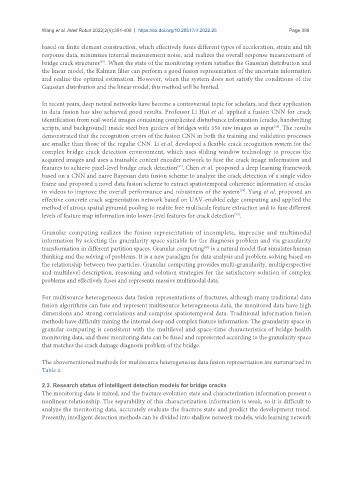Page 93 - Read Online
P. 93
Wang et al. Intell Robot 2022;2(4):391-406 https://dx.doi.org/10.20517/ir.2022.25 Page 399
based on finite element construction, which effectively fuses different types of acceleration, strain and tilt
response data, minimizes internal measurement noise, and realizes the overall response measurement of
[55]
bridge crack structures . When the state of the monitoring system satisfies the Gaussian distribution and
the linear model, the Kalman filter can perform a good fusion representation of the uncertain information
and realize the optimal estimation. However, when the system does not satisfy the conditions of the
Gaussian distribution and the linear model, this method will be limited.
In recent years, deep neural networks have become a controversial topic for scholars, and their application
in data fusion has also achieved good results. Professor Li Hui et al. applied a fusion CNN for crack
identification from real-world images containing complicated disturbance information (cracks, handwriting
[56]
scripts, and background) inside steel box girders of bridges with 350 raw images as input . The results
demonstrated that the recognition errors of the fusion CNN in both the training and validation processes
are smaller than those of the regular CNN. Li et al. developed a flexible crack recognition system for the
complex bridge crack detection environment, which uses sliding window technology to process the
acquired images and uses a trainable context encoder network to fuse the crack image information and
[57]
features to achieve pixel-level bridge crack detection . Chen et al. proposed a deep learning framework
based on a CNN and naive Bayesian data fusion scheme to analyze the crack detection of a single video
frame and proposed a novel data fusion scheme to extract spatiotemporal coherence information of cracks
in videos to improve the overall performance and robustness of the system . Yang et al. proposed an
[58]
effective concrete crack segmentation network based on UAV-enabled edge computing and applied the
method of atrous spatial pyramid pooling to realize free multiscale feature extraction and to fuse different
levels of feature map information into lower-level features for crack detection .
[59]
Granular computing realizes the fusion representation of incomplete, imprecise and multimodal
information by selecting the granularity space suitable for the diagnosis problem and via granularity
[60]
transformation in different partition spaces. Granular computing is a natural model that simulates human
thinking and the solving of problems. It is a new paradigm for data analysis and problem-solving based on
the relationship between two particles. Granular computing provides multi-granularity, multiperspective
and multilevel description, reasoning and solution strategies for the satisfactory solution of complex
problems and effectively fuses and represents massive multimodal data.
For multisource heterogeneous data fusion representations of fractures, although many traditional data
fusion algorithms can fuse and represent multisource heterogeneous data, the monitored data have high
dimensions and strong correlations and comprise spatiotemporal data. Traditional information fusion
methods have difficulty mining the internal deep and complex feature information. The granularity space in
granular computing is consistent with the multilevel and space-time characteristics of bridge health
monitoring data, and these monitoring data can be fused and represented according to the granularity space
that matches the crack damage diagnosis problem of the bridge.
The abovementioned methods for multisource heterogeneous data fusion representation are summarized in
Table 2.
2.3. Research status of intelligent detection models for bridge cracks
The monitoring data is mixed, and the fracture evolution state and characterization information present a
nonlinear relationship. The separability of this characterization information is weak, so it is difficult to
analyze the monitoring data, accurately evaluate the fracture state and predict the development trend.
Presently, intelligent detection methods can be divided into shallow network models, wide learning network

